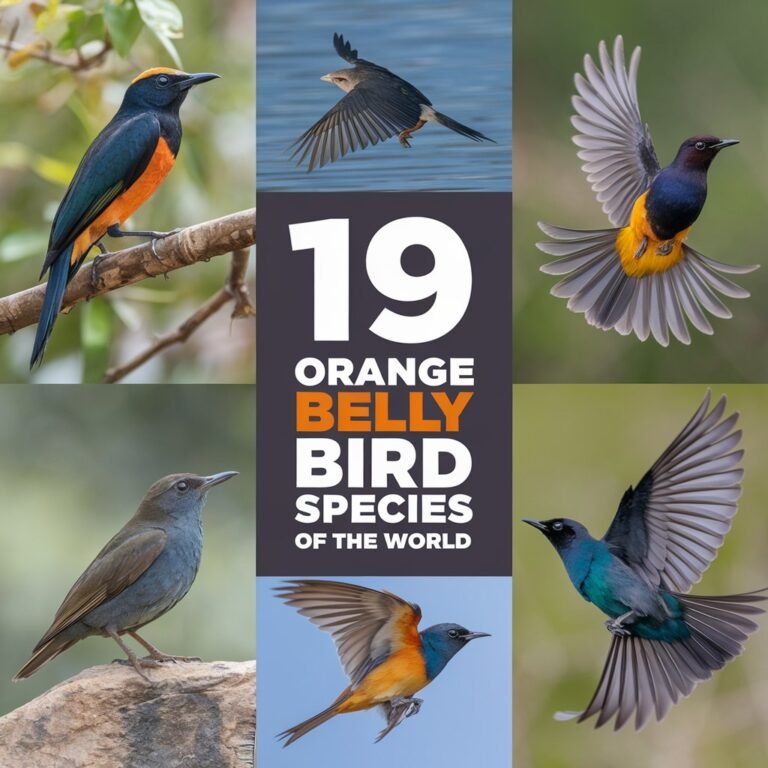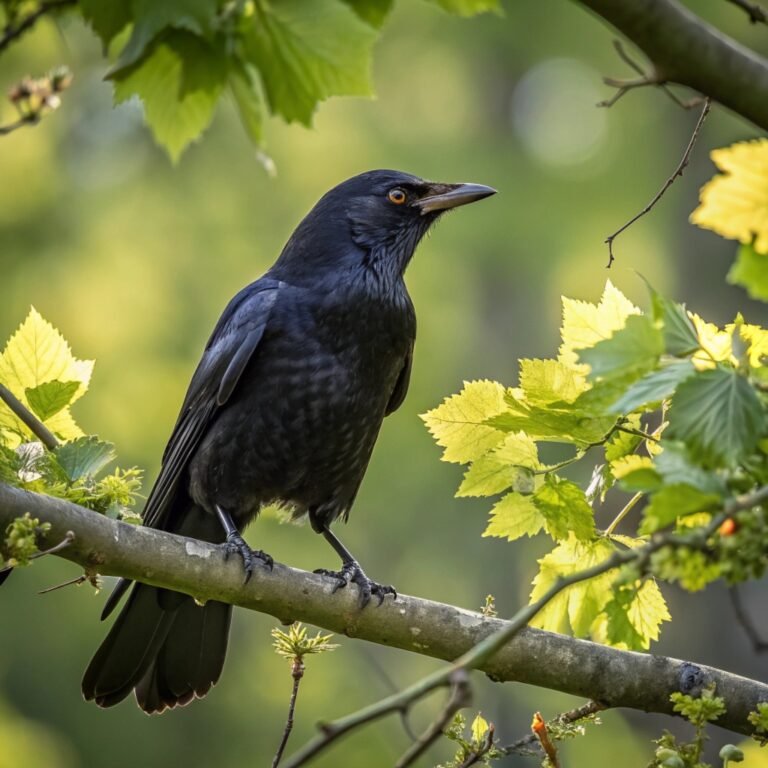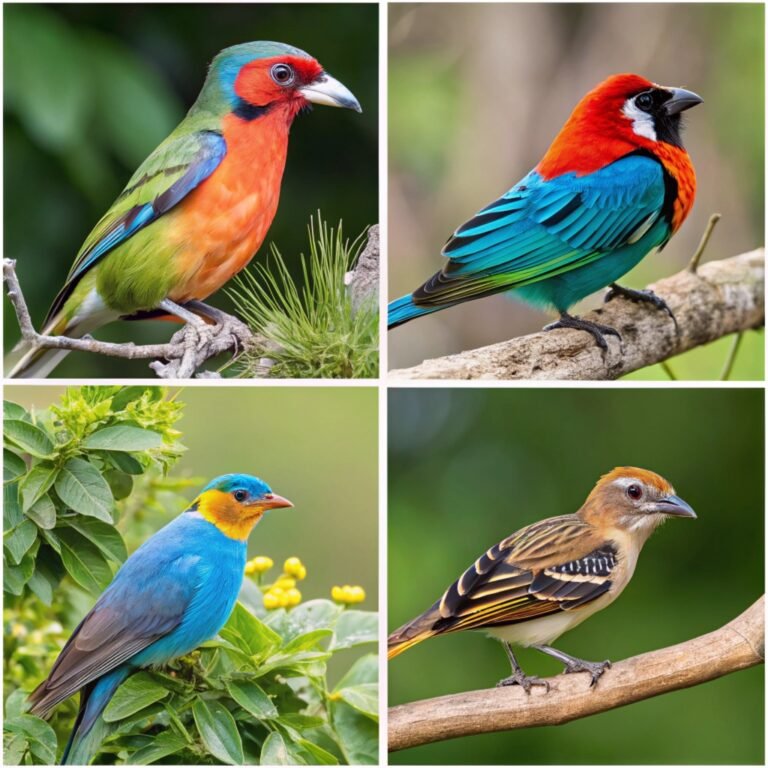10 Florida Birds of Prey Species: A Comprehensive Guide to These Powerful and Majestic Raptors of the Sunshine State
Florida’s diverse ecosystems provide a haven for an impressive array of birds of prey, also known as raptors.
These magnificent creatures play a crucial role in maintaining ecological balance and captivate observers with their power, grace, and hunting prowess. In this comprehensive guide, we’ll explore ten remarkable Florida birds of prey, delving into their unique characteristics, habitats, and behaviors.
From the iconic Bald Eagle to the lesser-known Crested Caracara, each species contributes to the rich tapestry of Florida’s avian wildlife.
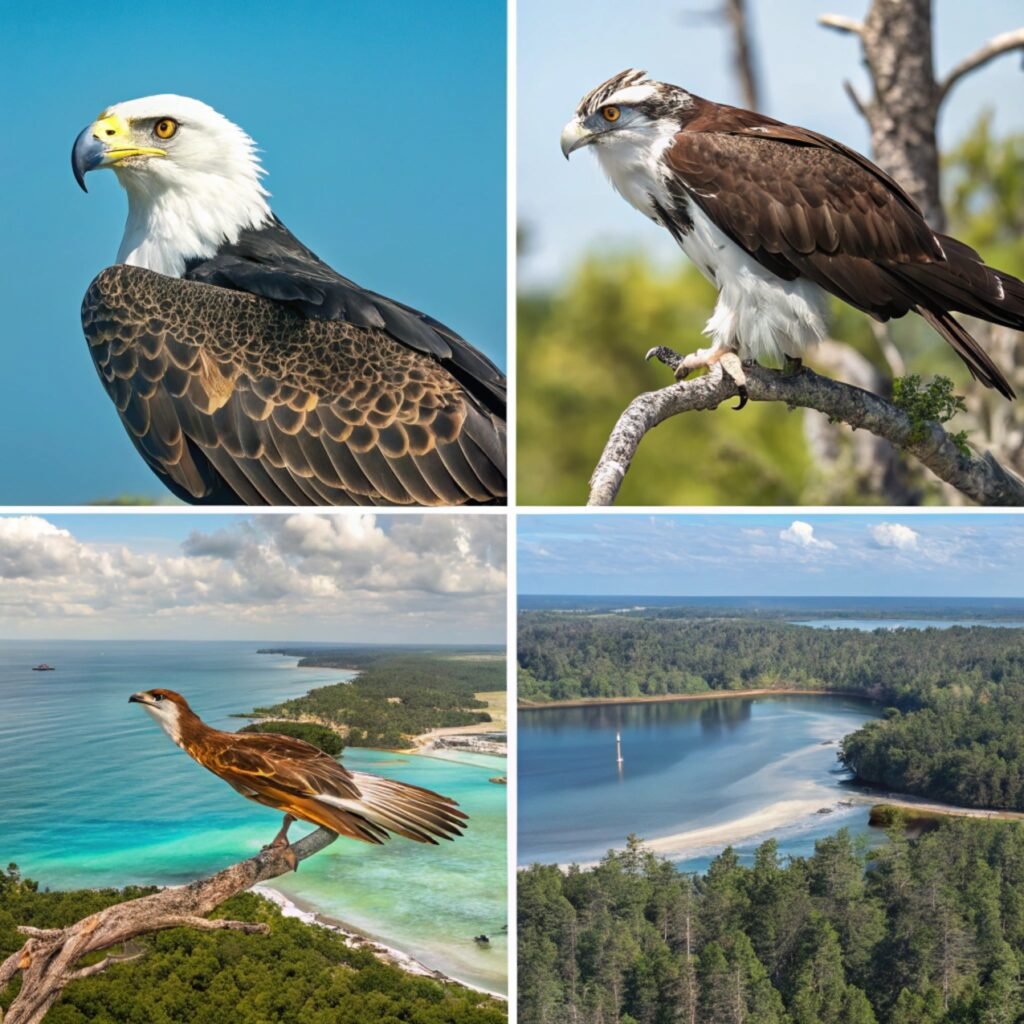
Key Takeaways
- Diverse Habitats: Florida’s varied ecosystems support a wide range of raptor species, from coastal areas to inland forests.
- Ecological Importance: Raptors play a vital role in controlling populations of rodents, reptiles, and other small animals.
- Conservation Status: Many Florida raptors are protected under federal and state laws, including the Migratory Bird Treaty Act and the Bald and Golden Eagle Protection Act.
- Adaptations: Each species has unique adaptations for hunting, from the Osprey’s fish-catching abilities to the Peregrine Falcon’s incredible speed.
- Year-round Residents: Some species, like the Red-shouldered Hawk, are permanent residents, while others are migratory visitors.
- Nesting Behaviors: Florida’s raptors exhibit diverse nesting habits, from the massive nests of Bald Eagles to the ground nests of Burrowing Owls.
- Diet Variations: Prey preferences range from fish and small mammals to insects and other birds, depending on the species.
- Conservation Success: Several species, including the Bald Eagle, have shown population recoveries due to conservation efforts.
- Observation Opportunities: Florida offers numerous locations for birdwatchers to observe these majestic creatures in their natural habitats.
- Human Impact: Understanding and protecting these birds is crucial for maintaining Florida’s ecological balance and biodiversity.
1. Bald Eagle (Haliaeetus leucocephalus)
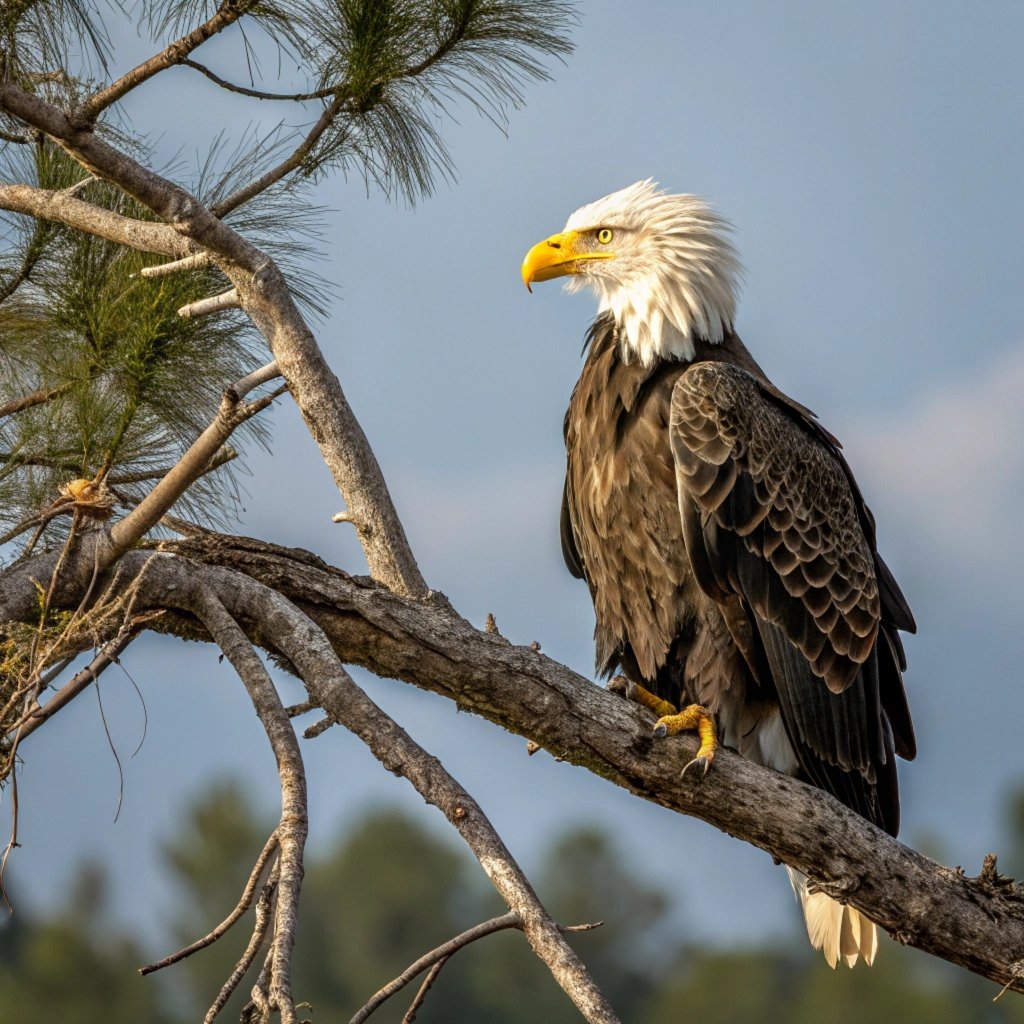
The Bald Eagle, America’s national symbol, is a majestic raptor that commands attention in Florida’s diverse landscapes.
Recognizable by its striking white head and tail contrasting with a dark brown body, this iconic bird of prey has established a year-round presence in the Sunshine State. Bald Eagles are often associated with large bodies of water, including lakes, rivers, and coastal habitats.
These powerful hunters primarily feed on fish but are also known to prey on waterfowl and small mammals. In Florida, Bald Eagles construct massive nests, often situated high in the canopy of tall trees near water bodies.
Their population has shown remarkable recovery after facing significant declines due to habitat loss and pesticide use. Today, approximately 1,500 nesting pairs reside in Florida, a testament to successful conservation efforts.
The Bald Eagle’s resilience and adaptability to coexist with human activities make it a symbol of both national pride and environmental stewardship in Florida.
2. Osprey (Pandion haliaetus)
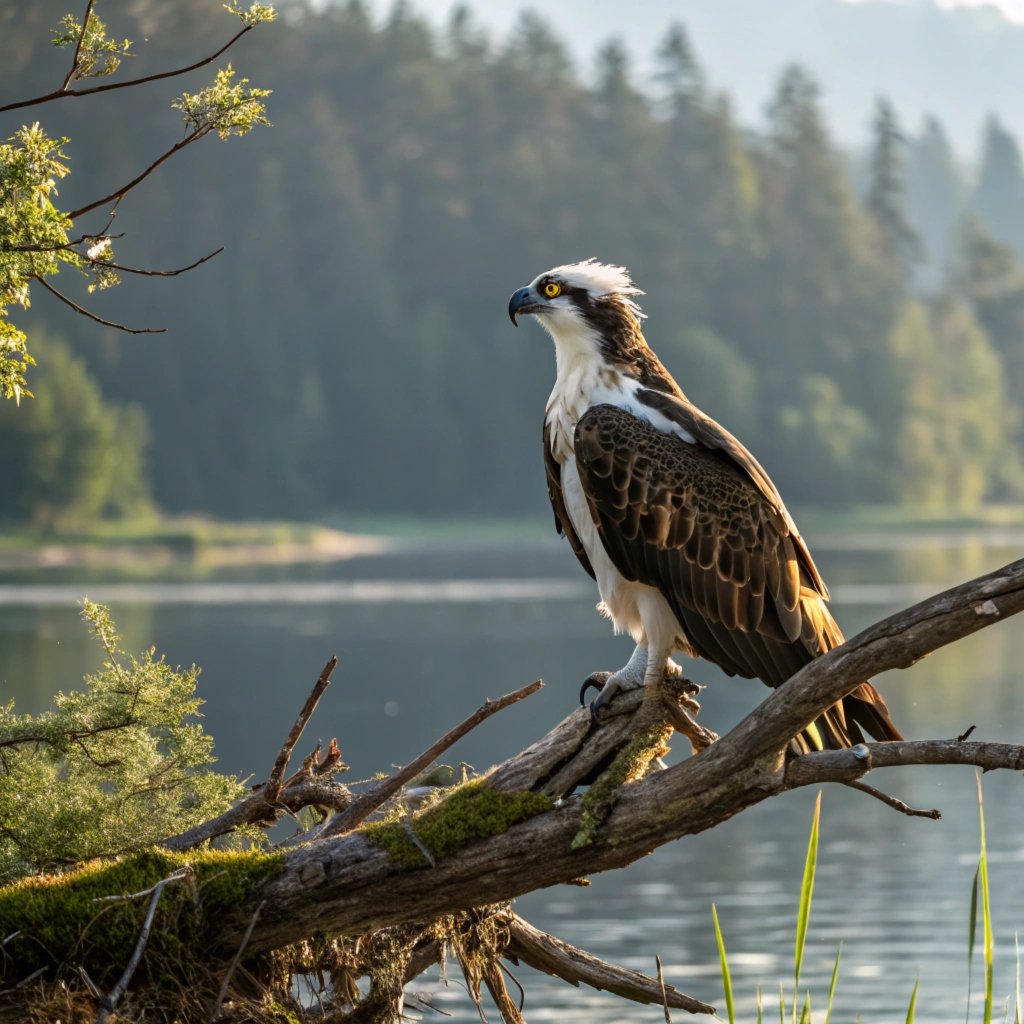
The Osprey, often called the “fish hawk,” is a distinctive raptor commonly found near Florida’s coasts, lakes, and rivers. These skilled fishermen are easily recognized by their white underparts, dark brown upperparts, and distinctive black eye stripe.
Ospreys are uniquely adapted for catching fish, with specialized talons and reversible outer toes that allow them to grasp slippery prey securely.
One of the most remarkable features of Ospreys is their ability to dive feet-first into water at speeds exceeding 100 miles per hour to catch fish.
In Florida, Ospreys often build their large stick nests on top of high structures, including wood telephone poles, particularly visible throughout the Florida Keys.
These raptors play a crucial role in controlling fish populations and are considered indicators of environmental health.
Despite facing challenges from habitat loss, Florida’s Osprey population remains relatively stable, thanks in part to conservation efforts and their adaptability to human-made nesting platforms.
3. Red-shouldered Hawk (Buteo lineatus)

The Red-shouldered Hawk is one of Florida’s most common and adaptable raptors, thriving in a variety of wooded habitats throughout the state. These medium-sized hawks are easily identified by their rusty-red “shoulders” and distinctively banded tail.
Red-shouldered Hawks are year-round residents in Florida, where they play a vital role in controlling populations of small mammals, reptiles, and amphibians.
These hawks are known for their distinctive, high-pitched “kee-aah” call, which often echoes through Florida’s forests and suburban areas. They typically build their nests in the forks of large trees, preferring deciduous species near water sources.
Red-shouldered Hawks have shown remarkable adaptability to human-altered landscapes, often seen perched on utility poles or soaring over neighborhoods. Their ability to thrive in diverse habitats, from swamps to urban parks, has contributed to their stable population in Florida.
These beautiful raptors serve as excellent indicators of ecosystem health and biodiversity in the state’s varied landscapes.
4. Swallow-tailed Kite (Elanoides forficatus)
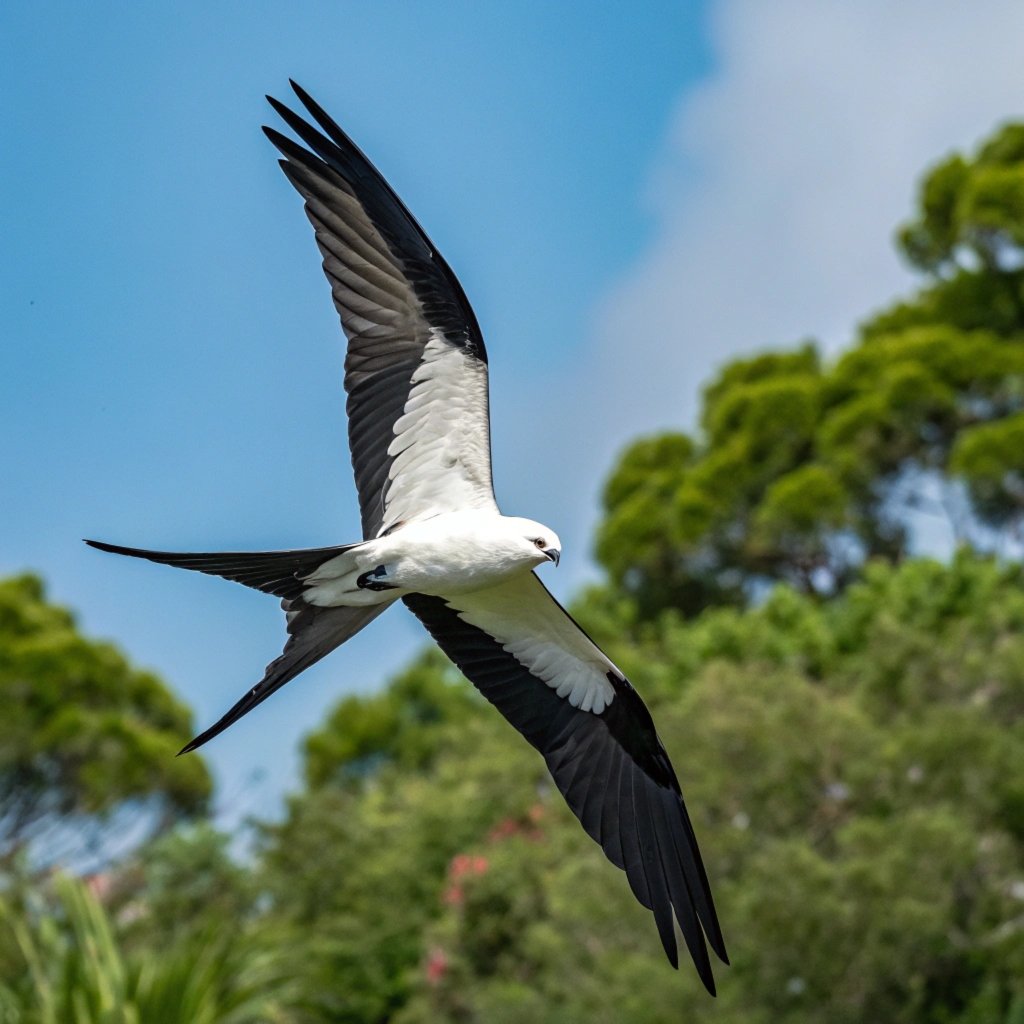
The Swallow-tailed Kite is one of Florida’s most graceful and distinctive raptors, easily recognized by its deeply forked tail and contrasting black and white plumage.
These elegant birds are summer residents in Florida, arriving in late February or early March to breed before migrating to South America for the winter. Swallow-tailed Kites are aerial acrobats, spending much of their time in flight and even feeding on the wing.
Their diet primarily consists of insects, small reptiles, and tree frogs, which they skillfully pluck from the air or from treetops. In Florida, these kites prefer to nest in tall trees within forested wetlands or pine savannas.
Their population has faced challenges due to habitat loss, but conservation efforts have helped stabilize their numbers in recent years.
The sight of Swallow-tailed Kites soaring effortlessly through Florida’s skies, performing intricate aerial maneuvers, is a testament to the state’s rich biodiversity and the importance of preserving natural habitats for these magnificent birds.
5. Great Horned Owl (Bubo virginianus)
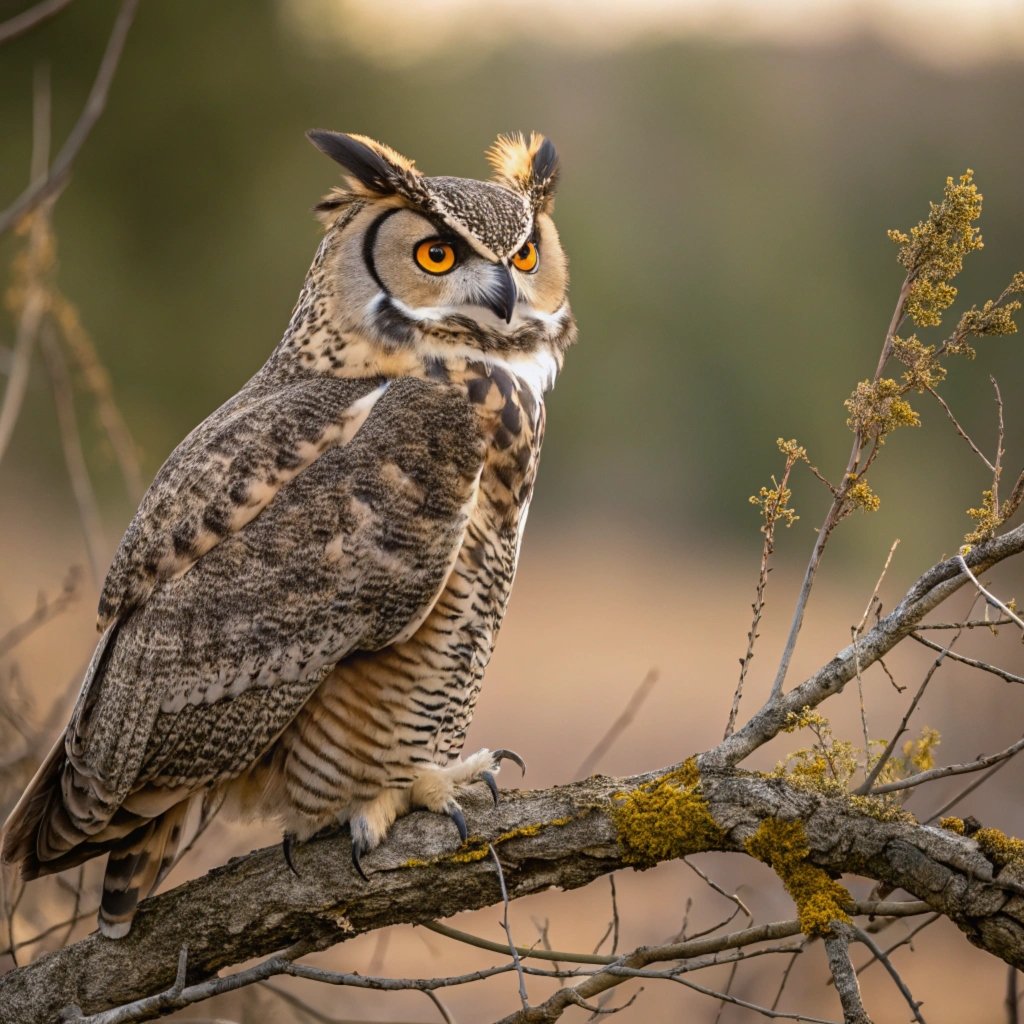
The Great Horned Owl, often called the “tiger owl” due to its fierce hunting abilities, is a formidable nocturnal raptor found throughout Florida. These large owls are easily identified by their prominent ear tufts and piercing yellow eyes.
Great Horned Owls are adaptable predators, inhabiting a wide range of environments from dense forests to urban areas. Their diet is diverse, including small mammals, birds, reptiles, and even other raptors.
In Florida, these owls often take over abandoned nests of other large birds, such as hawks or herons, to raise their young.
Great Horned Owls are known for their distinctive deep hooting call, which can often be heard echoing through Florida’s nights. Despite being primarily nocturnal, they can sometimes be spotted during twilight hours perched in trees or on utility poles.
Their presence in an ecosystem indicates a healthy and diverse prey base, making them important indicators of environmental health in Florida’s varied habitats.
6. Peregrine Falcon (Falco peregrinus)

The Peregrine Falcon is renowned as one of the fastest animals on Earth, capable of reaching diving speeds of up to 200 miles per hour.
While not a common breeding resident in Florida, these impressive raptors are regular visitors during migration seasons, following their prey along the Atlantic flyway.
Peregrines are medium-sized falcons with a distinctive dark “helmet” marking on their head and powerful, pointed wings adapted for high-speed flight.
In Florida, they can often be spotted along coastlines and in urban areas, where tall buildings mimic their natural cliff-side habitats. Peregrine Falcons are expert hunters of small to medium-sized birds, using their incredible speed to strike prey in mid-air.
Their presence in Florida during migration periods adds to the state’s rich raptor diversity and provides birdwatchers with exciting opportunities to observe these aerial hunters in action.
The recovery of Peregrine Falcon populations after the ban on DDT is a notable conservation success story, highlighting the importance of environmental protection measures.
7. Crested Caracara (Caracara plancus)
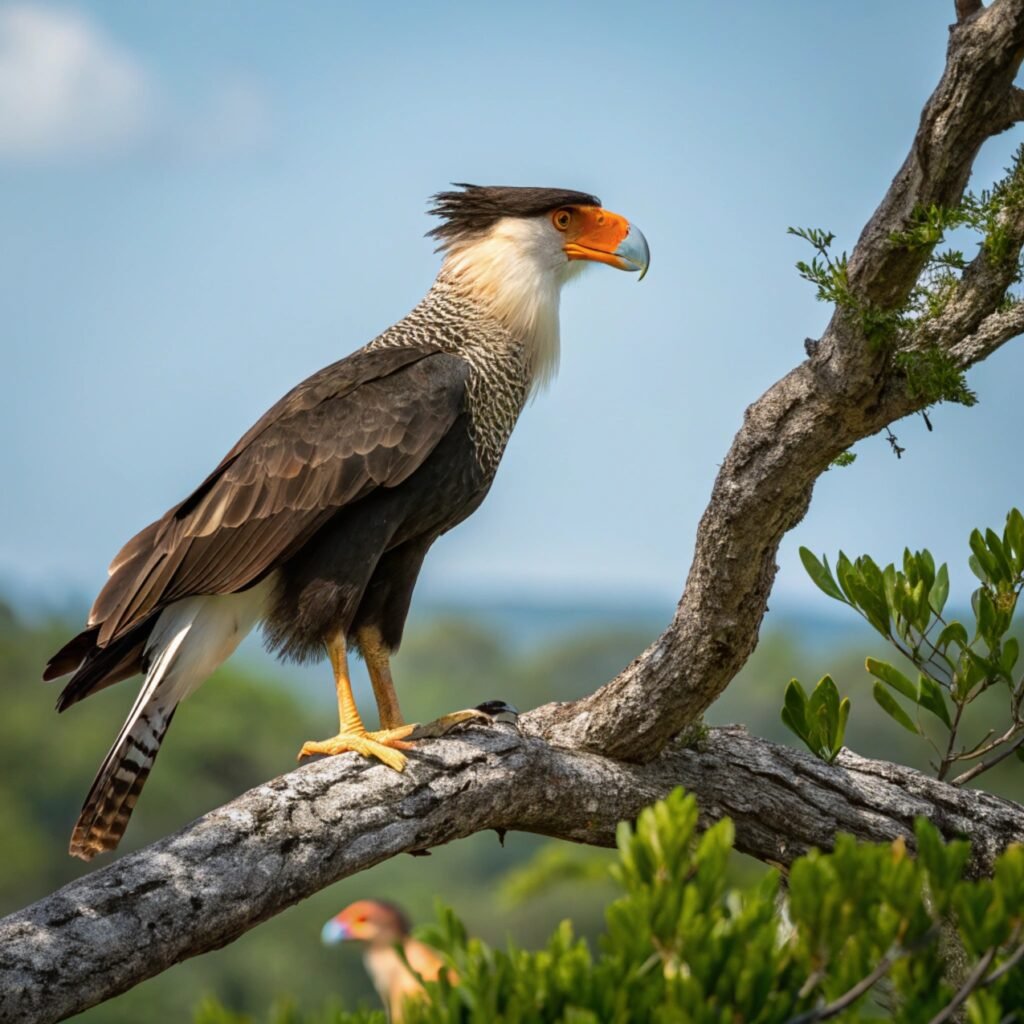
The Crested Caracara, sometimes called the “Mexican Eagle,” is a unique and striking raptor found in Florida’s southern and central regions. These large, long-legged birds of prey are easily identified by their black bodies, white neck and tail, and distinctive bare, red face with a heavy bill.
Crested Caracaras are members of the falcon family but behave more like vultures, often seen scavenging roadkill alongside Turkey Vultures and Black Vultures.
In Florida, they inhabit open grasslands, pastures, and prairies, where they hunt for small animals and insects in addition to scavenging. Caracaras are known for their intelligence and adaptability, often following farm machinery to catch disturbed prey.
Their presence in Florida represents the northernmost extent of their range, making them a special sight for birdwatchers. Conservation efforts are crucial for this species, as habitat loss due to agricultural and urban development poses a significant threat to their Florida populations.
8. American Kestrel (Falco sparverius)
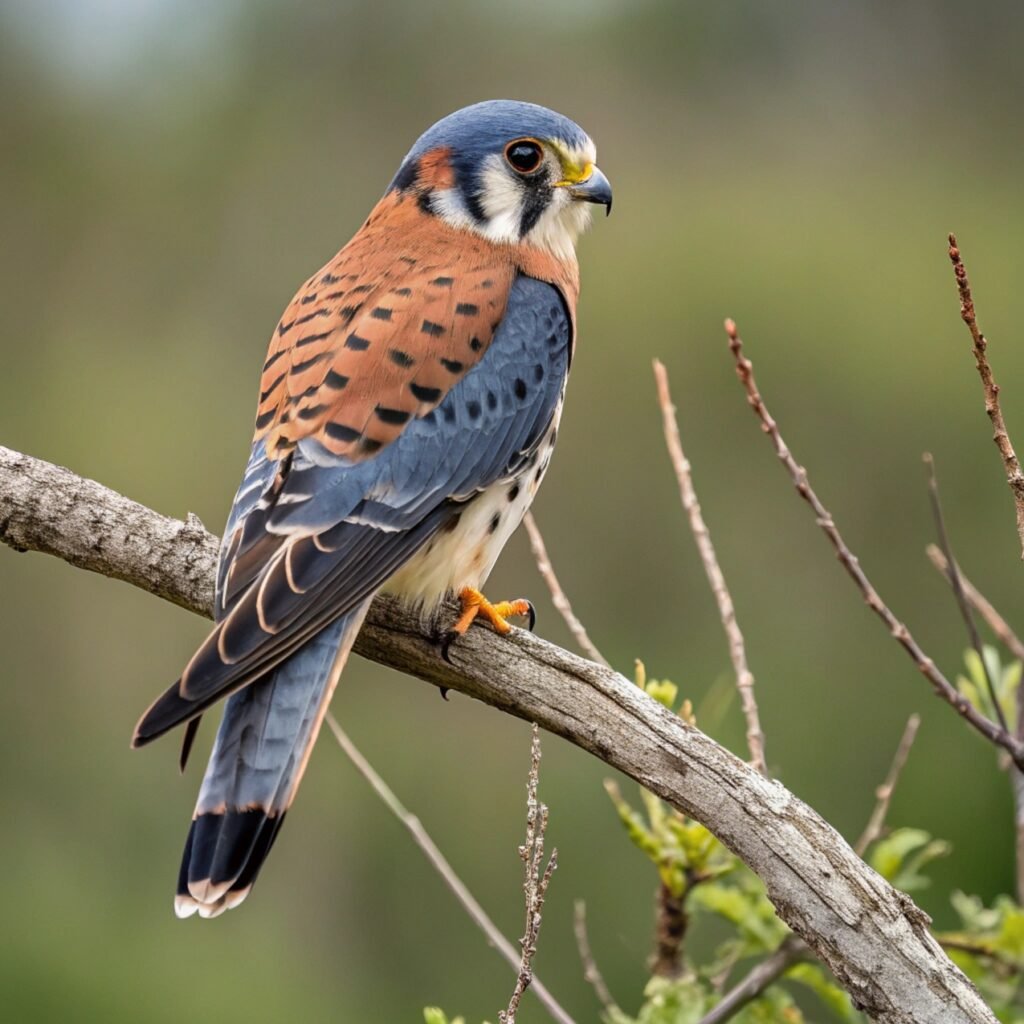
The American Kestrel, North America’s smallest falcon, is a colorful and charismatic raptor found throughout Florida. These diminutive birds of prey are easily recognized by their rusty-red back and tail, slate-blue wings, and distinctive facial markings.
Despite their small size, American Kestrels are fierce hunters, preying on insects, small mammals, and occasionally small birds.
In Florida, they can be found in open habitats such as fields, pastures, and even urban areas, often seen perched on utility wires or hovering over grassy areas while hunting.
American Kestrels are cavity nesters, utilizing natural tree hollows, abandoned woodpecker holes, or man-made nest boxes. While some kestrels are year-round residents in Florida, their numbers increase during winter months as northern populations migrate south.
Conservation efforts, including the installation of nest boxes, have helped support kestrel populations in areas where natural nesting sites are scarce. Their presence in Florida’s diverse landscapes adds a splash of color and vitality to the state’s raptor community.
9. Barred Owl (Strix varia)

The Barred Owl, known for its distinctive “who-cooks-for-you” call, is a common resident in Florida’s wooded areas and swamps.
These large, round-headed owls are easily identified by their brown and white striped (or “barred”) plumage and dark eyes, which set them apart from other owl species.
Barred Owls are adaptable predators, hunting a variety of prey including small mammals, birds, amphibians, and even fish. In Florida, they are often associated with mature forests and wetland areas, where they nest in tree cavities or take over abandoned hawk nests.
Unlike many owl species, Barred Owls are sometimes active during daylight hours, especially in deeply shaded forests. Their presence in an ecosystem indicates a healthy and diverse prey base, making them important indicators of forest health.
In recent years, Barred Owls have shown remarkable adaptability to suburban environments, often nesting in large trees in residential areas. This adaptability has helped maintain stable populations in Florida despite habitat changes in some areas.
10. Snail Kite (Rostrhamus sociabilis)
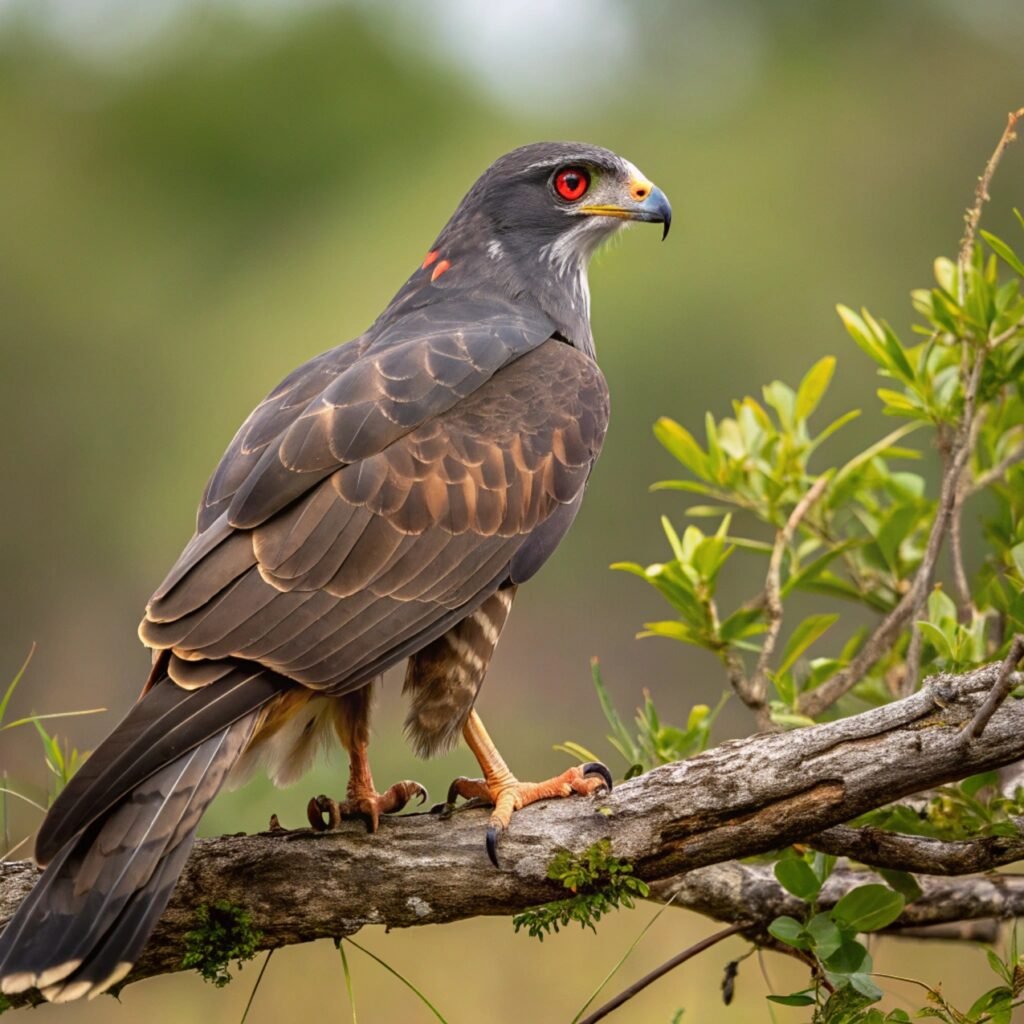
The Snail Kite is a highly specialized raptor that plays a unique role in Florida’s wetland ecosystems. These medium-sized hawks are easily recognized by their slender, hooked bills adapted for their primary prey: apple snails.
In Florida, Snail Kites are found in freshwater marshes and shallow lakes, particularly in the central and southern parts of the state. Males are slate-gray with a white rump, while females and immature birds are brown with streaked underparts.
Snail Kites are excellent indicators of wetland health, as their populations are closely tied to the availability of apple snails and the quality of their habitat.
Conservation efforts for this species have been crucial, as they face challenges from habitat loss, water management practices, and the introduction of exotic snail species.
The Snail Kite’s presence in Florida represents the northernmost extent of its range, making it a species of particular interest to both conservationists and birdwatchers.
Their unique feeding behavior, often seen hovering over marshes before plucking snails from the water, provides a fascinating glimpse into the specialized adaptations of Florida’s diverse raptor community.
Frequently Asked Questions
What is the most common bird of prey in Florida?
The Red-shouldered Hawk is one of the most common birds of prey in Florida. These adaptable raptors are found throughout the state in various wooded habitats, from forests to suburban areas.
Are there any endangered birds of prey in Florida?
While not currently endangered, the Snail Kite is listed as federally endangered due to its limited range and specialized habitat requirements. Conservation efforts are ongoing to protect this unique species.
How can I identify a Bald Eagle in Florida?
Adult Bald Eagles are easily identified by their distinctive white head and tail contrasting with a dark brown body. Immature eagles are mostly brown and can be confused with other large raptors.
What is the fastest bird of prey in Florida?
The Peregrine Falcon is the fastest bird of prey in Florida and the world, capable of reaching diving speeds up to 200 miles per hour when hunting.
Where can I observe Ospreys in Florida?
Ospreys are commonly seen near coastal areas, lakes, and rivers throughout Florida. They often build large nests on platforms or utility poles near water bodies.
What is the smallest bird of prey in Florida?
The American Kestrel is the smallest falcon and one of the smallest birds of prey in Florida, measuring only about 9 inches in length.
How do Snail Kites hunt their prey?
Snail Kites use their specialized, curved beaks to extract apple snails from their shells. They often hover over marshes before swooping down to catch snails from the water’s surface.
Are owls considered birds of prey?
Yes, owls are considered birds of prey. Florida is home to several owl species, including the Great Horned Owl and Barred Owl, which are active nocturnal predators.
What role do vultures play in Florida’s ecosystem?
While not typically considered raptors, vultures like the Turkey Vulture and Black Vulture play a crucial role in Florida’s ecosystem as scavengers, helping to clean up carrion and prevent the spread of disease.
How can I contribute to raptor conservation in Florida?
You can contribute to raptor conservation by supporting local wildlife organizations, participating in citizen science projects, avoiding the use of harmful pesticides, and respecting wildlife habitats during outdoor activities.

Hello, I’m Emily Price, the founder of Birds Affection. As a passionate bird enthusiast and spiritual seeker, I’ve always been fascinated by the symbolic meanings and mystical connections between birds and our lives. On this website, I share my knowledge and insights on the spiritual significance of various bird species, exploring their roles as messengers, guides, and teachers. Through my writing, I aim to inspire and educate others on the profound wisdom and beauty that birds bring to our world. Join me on this journey as we delve into the enchanting realm of bird symbolism and discover the hidden meanings behind these magnificent creatures.


